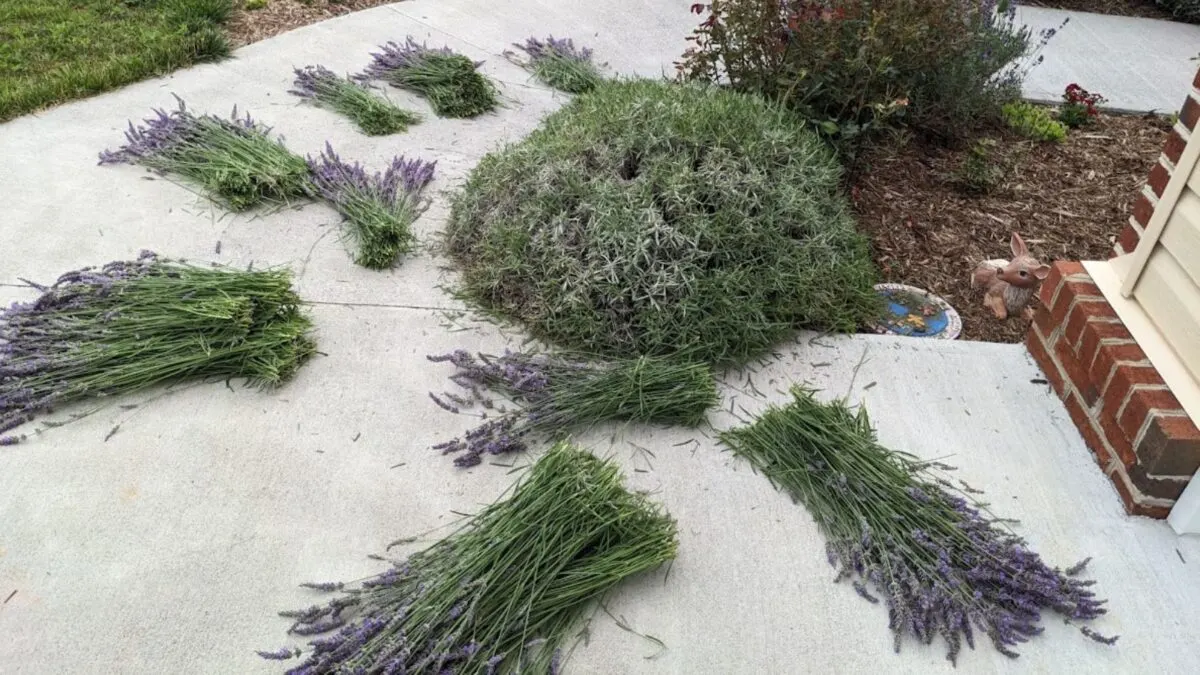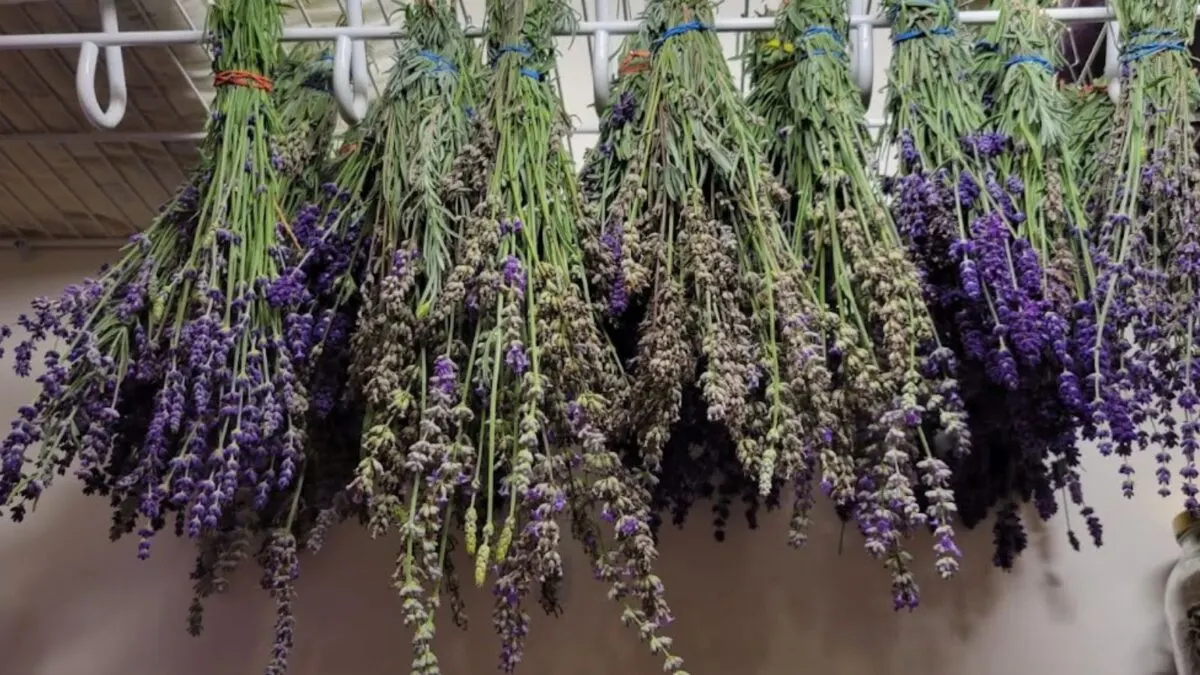A lavender hedge might be the perfect addition to your outdoor space if you love lavender and neat, orderly gardens. Almost as tidy as boxwoods but decidedly more colorful and fragrant, a lavender hedge gives a classical garden an extra spark of interest and beauty. But before you dive in, it’s important to understand how to plant a lavender hedge properly. The proper preparation and ongoing care will ensure your lavender hedge thrives for years to come.

Why Plant a Lavender Hedge?

The benefits of a lavender hedge are myriad. First, lavender flowers come not only in, well, lavender but in hues ranging from deep purple to pink to white, making for a stunning display of color. The silvery green leaves remain on the plant year-round, offering winter interest as well. And, with annual pruning, each plant maintains a neat, compact mounded shape.
Speaking of maintenance, lavender hedges require very little care. Lavenders prefer average to poor, dry soils, so they don’t need feeding or watering after they have been established.
The wonderful fragrance, of course, wafts up to please passersby when lavender grows along walkways or around patios to be brushed against. This scent also deters garden pests, while the bright flowers attract beneficial insects like bees and butterflies, making a lavender hedge a great addition to a vegetable garden.
A low-growing lavender hedge can provide beautiful edging around garden beds, line pathways or patios for fragrant strolls through the garden, or create other low borders.
How to Plant a Lavender Hedge

Establishing a lavender hedge is quite simple. First, you get to daydream a bit and decide what you want your lavender hedge to look like.
- Where will it go?
- What purpose will it serve?
Look at your garden and consider where you want your lavender hedge and what conditions it needs. Lavender requires full sun and doesn’t like wet feet, so good drainage and a sunny spot are essential.
Next, consider the different lavender varieties available. These vary in size, color, hardiness, and appearance, so keep in mind how big you want your hedge, what you want it to look like, and your USDA growing zone.
English lavender (Lavandula angustifolia) varieties, such as Munstead and Hidcote, thrive in zones 5–9, making them a good choice for most regions in the US. Spanish (L. stoechas) and French (L. dentata) lavender often come in smaller sizes with showy flowers but require a warmer climate.
For a larger hedge, choose something like Grosso, a lavandin (L. x intermedia) that can grow to an impressive three feet tall.
Once you know what you want and have purchased your plants, it’s time to plant a lavender hedge!
1. Prepare the site

If you don’t already have clear lines to follow, such as the edge of a path or bed, use string and stakes or a garden hose to mark the layout of your lavender hedge. Then, unless you already have loose, well-draining soil, you might need to improve the soil structure. Mix in some organic matter like wood chips, compost, or even limestone gravel. Mounding the soil in a slight ridge can also help improve drainage.
2. Plant the lavender

The best time to plant lavender is late summer to early fall, as this will cause the least stress to the transplants and give them time to establish strong roots before the next active growing season. Late spring is the second best.
Space the plants 10 to 12 inches apart, depending on the mature size of the chosen variety. Stagger the second row if you plant a double row for a thicker, fuller hedge. To suppress weeds and prevent runoff, add a layer of pea gravel or other mulch to the top of the soil after planting the lavender.
Learn more about landscaping with lavender.
3. Water and wait

Immediately after planting, water each lavender plant thoroughly. Then, water about once a week — unless you get a good soaking rain — for the first three weeks or so. And remember that while you will likely see blossoms in the first summer, it may take up to three years for the plants to completely fill out and form a proper hedge.
How to Maintain a Lavender Hedge

Lavender requires very little care once established. But to maintain a tidy, compact shape, you must prune it once each year, beginning in the second year after planting. After the plants finish flowering in late summer or early fall, head outside with a pair of clean, sharp pruners.
Look for the woody base of the plant, and follow one stem up to where it becomes green and supple and the first leaves emerge. Trim off the rest of the stem about two to three inches up from that point. You want to ensure at least two nodes or sets of leaves remain on the stem below where you cut. Prune the whole plant this way, taking care to maintain a low, rounded shape.
Depending on the type of lavender you planted, you can use what you prune to make tea or essential oil or use the dried lavender buds in crafts.
Some varieties of lavender will rebloom if deadheaded. If you do not harvest the buds, walk along the hedge when you notice the flowers begin to fade and trim off any spent blooms to encourage a second flush of flowers.
Can you smell it yet? With just a few simple steps, you can have a low-maintenance lavender hedge in your garden, offering visual beauty all year round and a sweet, calming fragrance.
How to Harvest Lavender

Image credit: Backyard Garden Lover.
Harvesting and drying lavender is simple: start in the early morning when it’s cool outside and the fragrance and lavender oil concentration are at their peak. If you plan to dry what you harvest, just make sure to wait for the dew to dry up.
Pick and trim a handful of stems above a leaf node or a side branch. Do not cut too deep, or you’ll damage the stem.
Learn more about harvesting lavender.
How to Dry Lavender

Image credit: Backyard Garden Lover.
The important thing to remember when drying lavender is “low and slow.” For the best quality, you want to maintain a low temperature and humidity and allow the lavender to dry slowly.
Learn more about drying lavender.
Best Lavender Farms To Visit This Summer

Image credit: Backyard Garden Lover.
There’s nothing like being surrounded by calming, sweetly scented, purple lavender flowers. The bees’ hum and the butterflies’ dancing make it an amazing experience. Plan to take your family to a lavender farm this summer for an exquisite sensory experience. This directory of lavender farms by state will help you find lavender fields nearby.
Serena Manickam is a freelance editor and writer and sustainable market gardener in rural Virginia. She holds a BA in environmental science and runs Fairydiddle Farm, a small market garden in which she grows no-spray produce and herbs to sell at a local farmer’s market.



